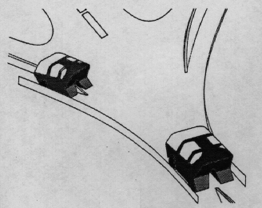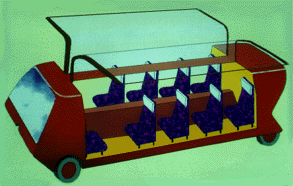
RUF vehicles remain under system control while negotiating the switching area

RUF vehicles remain under system control while
negotiating the switching area
The likely capital and operating costs of a RUF system are currently unknown but are being developed. In contrast to conventional rail transit investments, the automobile industry could participate in the deployment of this concept by manufacturing both the public and private vehicles to an adopted RUF standard. RUF guideways could be constructed off-site and moved to various locations to minimize construction disruptions. They would be located in heavily traveled corridors and, in some cases, would occupy existing lanes of the conventional freeway and arterial roadway system. In other cases, new rights-of-way would be required. The guideways could be financed and operated by the public or by private interests that would charge a toll for their use. Stations and adjacent joint developments could be financed and operated in a similar manner. Deployment of this technology would have to be incremental as the construction of the RUF network of guideways and the growth of the fleet of RUF vehicles would have to proceed in a carefully phased manner. Several deployment strategies have been devised which could be tailored to the unique circumstances of particular cities and cultures as necessary.

MAXI-RUF vehicles provide increased passenger capacity.
The potential benefits of adopting a RUF system are many and varied. Substantial reductions in congestion and air pollution are two benefits likely to be very significant. Noise and visual intrusion from a RUF elevated guideway should be minor in nature. Reductions in stress are likely on the automated portions of many intraurban trips. Reductions in the number of vehicles per household should be possible without any loss in household mobility levels. In fact, mobility might increase substantially, given the availability of a geographically large RUF system. Accident rates on the automated facility should be very close to zero.